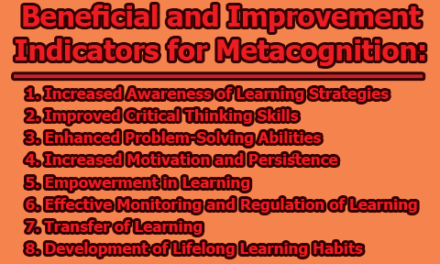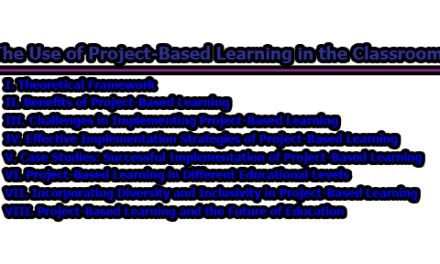Role of Positive Emotions in Working Memory among High School Learners:
Working memory is a fundamental cognitive process that allows individuals to temporarily store and manipulate information, facilitating complex cognitive tasks such as problem-solving, learning, and decision-making. For high school learners, an efficient working memory is critical for academic success, as it underlies tasks like reading comprehension, mathematical problem-solving, and information retention. Moreover, the emotional state of learners can significantly impact their cognitive processes, including working memory. Positive emotions, often overlooked in the context of cognitive processes, are increasingly being recognized as essential contributors to academic achievement and cognitive functioning. High school learners are susceptible to various emotional states, and understanding the role of positive emotions in working memory can help educators and students alike. This article will explore the role of positive emotions in working memory among high school learners.
Section 1: Theoretical Foundations
1.1 Working Memory: Working memory, as proposed by Baddeley and Hitch (1974), is a limited-capacity system responsible for temporarily holding and manipulating information. It comprises a central executive, responsible for attention control and cognitive coordination, and two subsidiary systems: the phonological loop, which temporarily stores auditory information, and the visuospatial sketchpad, which handles visual and spatial data. Working memory is vital for tasks that require active maintenance of information, such as mental arithmetic, reading, and problem-solving.
Working memory is a dynamic system that is sensitive to individual differences and susceptible to various factors, including emotional states. Research on working memory suggests that its capacity and efficiency can be influenced by external factors, such as stress, emotional arousal, and cognitive load (Baddeley, 2012). Understanding the role of emotions in working memory can provide valuable insights into how students’ cognitive functioning is impacted.
1.2 Positive Emotions: Positive emotions encompass a range of feelings, such as happiness, joy, contentment, and gratitude. These emotions are typically associated with positive experiences, achievement, and social interactions. Positive psychology, a field that gained prominence in the late 20th century, focuses on the study and promotion of positive emotions and overall well-being.
Positive emotions have been shown to have several benefits, including improved physical and mental health, enhanced resilience, and better social relationships. They are often linked to positive outcomes in various life domains, including education. The broaden-and-build theory of positive emotions, proposed by Fredrickson (2001), suggests that experiencing positive emotions broadens an individual’s thought-action repertoire and builds resources that can be drawn upon in the future. This theory implies that positive emotions may have a significant impact on cognitive functions, including working memory.
Section 2: Empirical Evidence:
Understanding the relationship between positive emotions and working memory among high school learners requires an examination of empirical evidence from psychological research. Several studies have investigated this connection, shedding light on how positive emotions can enhance working memory performance.
2.1 Positive Emotions and Working Memory Capacity: Research by Isen, Daubman, and Nowicki (1987) demonstrated that individuals in a positive emotional state showed enhanced working memory capacity. In their study, participants who experienced positive emotions were better at solving working memory tasks compared to those in neutral or negative emotional states. This suggests that the experience of positive emotions can expand working memory resources, potentially allowing high school learners to process and store more information simultaneously.
2.2 Positive Emotions and Attention Control: Working memory’s central executive component is responsible for attention control and cognitive coordination. Positive emotions have been found to influence attention allocation, potentially impacting working memory. In a study by Rowe et al. (2007), participants exposed to positive emotional stimuli demonstrated enhanced attention control and cognitive flexibility. This improved attentional focus and cognitive flexibility may translate into more efficient working memory use among high school learners experiencing positive emotions.
2.3 Positive Emotions and Cognitive Load: Cognitive load refers to the amount of mental effort required to process information. Positive emotions have been shown to reduce cognitive load, allowing individuals to allocate cognitive resources more efficiently. In a study by Fredrickson and Branigan (2005), participants induced into a positive emotional state showed decreased cognitive load during a working memory task. This suggests that high school learners experiencing positive emotions may have an advantage in managing cognitive load during complex academic tasks, ultimately leading to improved working memory performance.
2.4 Positive Emotions and Stress Reduction: High school learners often face stressors related to academic performance, peer relationships, and future uncertainties. Stress can have a detrimental impact on working memory, as it diverts cognitive resources towards managing the stress response. Positive emotions, on the other hand, have been found to reduce stress and its negative effects on working memory. Research by Oveis et al. (2009) demonstrated that experiencing positive emotions can buffer the impact of stress on working memory, potentially enhancing cognitive performance among high school students facing academic pressures.
2.5 Positive Emotions and Learning: Positive emotions can also play a role in the acquisition and retention of new information. Learning is a fundamental aspect of high school education, and working memory is intricately tied to the learning process. Positive emotions have been shown to promote effective learning strategies and information retention. A study by Ashby et al. (1999) found that learners who experienced positive emotions during a learning task exhibited better working memory performance when tested on the acquired knowledge. This suggests that positive emotions can facilitate the encoding and storage of information in working memory, which is vital for high school learners’ academic success.
Section 3: Practical Implications:
Understanding the role of positive emotions in working memory among high school learners has significant practical implications for educators, students, and parents. Implementing strategies to foster positive emotions can enhance cognitive functioning and overall academic performance. Here are some practical implications based on the evidence discussed:
3.1 Promote a Positive Classroom Environment: Educators can create a positive and supportive classroom environment that encourages positive emotions among students. This can be achieved by acknowledging students’ achievements, providing constructive feedback, and creating opportunities for social interaction and collaboration. A positive classroom atmosphere can help students experience more positive emotions, ultimately benefiting their working memory.
3.2 Incorporate Positive Psychology Interventions: Positive psychology interventions, such as gratitude exercises, mindfulness, and strengths-based activities, can be integrated into the curriculum. These interventions have been shown to enhance positive emotions and well-being. By incorporating them into high school education, educators can help students build emotional resilience and improve their working memory.
3.3 Teach Emotion Regulation Skills: Educators can also teach students emotion regulation skills. High school learners often experience a range of emotions, and the ability to regulate these emotions can have a profound impact on cognitive functioning. Teaching students how to manage stress, anxiety, and negative emotions can create a conducive environment for positive emotions to thrive.
3.4 Encourage Physical Activity: Physical activity has been linked to the release of endorphins and the promotion of positive emotions. Schools can incorporate physical education and encourage students to engage in regular physical activity, which can improve their emotional well-being and, in turn, benefit working memory.
3.5 Provide Social and Emotional Learning (SEL) Programs: Social and emotional learning programs focus on developing students’ emotional intelligence, self-awareness, and interpersonal skills. These programs can help high school learners understand and manage their emotions, fostering a positive emotional state that supports working memory.
3.6 Involve Parents and Guardians: Parents and guardians play a crucial role in shaping their children’s emotional experiences. Schools can collaborate with parents to ensure that a positive emotional environment is encouraged both at home and in the school setting. This collaboration can involve workshops and resources for parents to support their children’s emotional development.
Section 4: Future Directions and Challenges:
While the relationship between positive emotions and working memory among high school learners is well-established, there are still many areas that require further research. Some of the potential directions for future research include:
4.1 Longitudinal Studies: Longitudinal studies that track the impact of positive emotions on working memory over an extended period can provide valuable insights into the long-term effects. Understanding how sustained positive emotions influence working memory can guide educators in designing interventions for consistent cognitive development.
4.2 Individual Differences: High school learners exhibit substantial individual differences in their emotional experiences and working memory capacity. Future research can explore how individual traits, such as personality, impact the relationship between positive emotions and working memory.
4.3 Intervention Efficacy: Evaluating the effectiveness of various positive psychology interventions in educational settings is essential. Research can assess which interventions are most suitable for high school learners and their specific working memory needs.
4.4 Technological Interventions: With the integration of technology in education, researchers can explore how digital tools and applications can be used to enhance positive emotions and working memory in high school students.
4.5 Cultural and Contextual Factors: Culture and context can significantly influence the emotional experiences of high school learners. Research can investigate how cultural and contextual factors affect the relationship between positive emotions and working memory, particularly in diverse educational settings.
Challenges in conducting research on this topic include ethical considerations, as working with high school students requires informed consent and protection of minors. Additionally, the complex nature of emotions and working memory necessitates careful experimental design and measurement to ensure reliable and valid results.
In conclusion, working memory is a critical cognitive function that underlies high school learners’ academic success and overall cognitive development. Positive emotions play a vital role in enhancing working memory, as they influence attention control, cognitive load, stress reduction, and the learning process. Recognizing the intricate connection between positive emotions and working memory has significant practical implications for educators, students, and parents. Strategies for fostering positive emotions in high school learners can lead to improved cognitive functioning, better academic performance, and enhanced overall well-being.
As research in this field continues to expand, educators and researchers must work collaboratively to develop and implement evidence-based interventions that promote positive emotions and support working memory. By doing so, high school learners can experience a more conducive and emotionally positive learning environment, setting the stage for their cognitive growth and academic success.
The role of positive emotions in working memory among high school learners is a complex and evolving field of research with substantial implications for education and student well-being. Understanding this relationship can pave the way for more effective educational strategies and ultimately contribute to the holistic development of high school students.
Frequently Asked Questions [FAQs]:
What is working memory, and why is it important for high school learners?
Working memory is a cognitive system responsible for temporarily holding and manipulating information. It’s crucial for tasks like problem-solving, reading, and learning. High school learners rely on working memory for academic success and cognitive development.
What are positive emotions, and why do they matter in high school education?
Positive emotions, such as happiness, joy, and gratitude, play a significant role in emotional well-being. They have been linked to improved mental health, resilience, and better academic performance. Understanding their role in high school education is essential for creating a conducive learning environment.
How do positive emotions impact working memory in high school learners?
Positive emotions have been shown to enhance working memory by increasing working memory capacity, improving attention control, reducing cognitive load, and mitigating the negative effects of stress on working memory.
Are there practical strategies for educators to foster positive emotions in the classroom?
Yes, educators can create a positive classroom environment by acknowledging students’ achievements, incorporating positive psychology interventions, teaching emotion regulation skills, encouraging physical activity, and providing social and emotional learning (SEL) programs.
What is the broaden-and-build theory of positive emotions, and how does it relate to working memory?
The broaden-and-build theory, proposed by Barbara Fredrickson, suggests that positive emotions broaden an individual’s thought-action repertoire and build resources for the future. This theory implies that positive emotions can expand working memory resources, potentially allowing high school learners to process and store more information simultaneously.
What are the challenges in conducting research on the relationship between positive emotions and working memory among high school learners?
Challenges in research include ethical considerations when working with minors, the need for careful experimental design and measurement, and the complexity of emotions and working memory.
What are some potential future directions for research in this field?
Future research may include longitudinal studies, examining individual differences, assessing the efficacy of positive psychology interventions, exploring technological interventions, and considering cultural and contextual factors in diverse educational settings.
How can parents and guardians contribute to the development of positive emotions in high school learners?
Parents and guardians can play a crucial role by collaborating with schools to ensure a positive emotional environment at home and in the school setting. They can also support their children’s emotional development through workshops and resources.
How can educators and researchers work together to promote positive emotions in high school education?
Educators and researchers can collaborate to develop and implement evidence-based interventions that promote positive emotions in the classroom. By sharing knowledge and strategies, they can create a more conducive learning environment for high school students.
Why is it important to understand the role of positive emotions in working memory for high school learners?
Understanding this relationship is essential because it can lead to the development of more effective educational strategies that contribute to the holistic development of high school students. It can improve their cognitive functioning, academic performance, and overall well-being.
References:
- Ashby, F. G., Isen, A. M., & Turken, A. U. (1999). A neuropsychological theory of positive affect and its influence on cognition. Psychological Review, 106(3), 529-550.
- Baddeley, A. (2012). Working memory: Theories, models, and controversies. Annual Review of Psychology, 63, 1-29.
- Baddeley, A. D., & Hitch, G. J. (1974). Working memory. Psychology of Learning and Motivation, 8, 47-89.
- Fredrickson, B. L. (2001). The role of positive emotions in positive psychology: The broaden-and-build theory of positive emotions. American Psychologist, 56(3), 218-226.
- Fredrickson, B. L., & Branigan, C. (2005). Positive emotions broaden the scope of attention and thought-action repertoires. Cognition & Emotion, 19(3), 313-332.
- Isen, A. M., Daubman, K. A., & Nowicki, G. P. (1987). Positive affect facilitates creative problem-solving. Journal of Personality and Social Psychology, 52(6), 1122-1131.
- Oveis, C., Horberg, E. J., & Keltner, D. (2009). Compassion, pride, and social intuitions of self-other similarity. Journal of Personality and Social Psychology, 96(6), 1140-1159.
- Rowe, G., Hirsh, J. B., & Anderson, A. K. (2007). Positive affect increases the breadth of attentional selection. Proceedings of the National Academy of Sciences, 104(1), 383-388.

Library Lecturer at Nurul Amin Degree College










